 | ||
Soviet Naval Aviation (AV-MF, for Авиация военно-морского флота in Russian, or Aviacija vojenno-morskogo flota, literally "aviation of the military maritime fleet") was a part of the Soviet Navy.
Contents
Origins
The first naval aviation units in Russia were formed in 1912–1914 as a part of the Baltic Fleet and the Black Sea Fleet. During World War I, the hydroplane units were used in the Black Sea for conducting aircraft reconnaissance, bombing and firing at coastal and port installations and enemy ships, and destroying submarines and enemy aircraft on the airfields.
Civil War and Interwar Period
The regular Soviet naval aviation units were created in 1918. They participated in the Russian Civil War, cooperating with the ships and the army during the combats at Petrograd, on the Baltic Sea, the Black Sea, the Volga, the Kama River, Northern Dvina and on the Lake Onega. The newborn Soviet Naval Air Force consisted of only 76 obsolete hydroplanes. Scanty and technically imperfect, it was mostly used for resupplying the ships and the army.
In the second half of the 1920s, the Naval Aviation order of battle began to grow. It received new reconnaissance hydroplanes, bombers, and fighters. In the mid-1930s, the Soviets created the Naval Air Force in the Baltic Fleet, the Black Sea Fleet and the Soviet Pacific Fleet. The importance of naval aviation had grown significantly by 1938–1940, to become one of the main components of the Soviet Navy. By this time, the Soviets had created formations and units of the torpedo and bomb aviation. At the beginning of the Great Patriotic War, all of the fleets (except for the Pacific Fleet) had a total of 1,445 aircraft.
Second World War
The Morskaya Aviatsiya (Naval Aviation) was the Soviet Navy's air service during World War II. Such air units provided air support to the Voyenno-Morskoy Flot SSSR (Soviet Navy) in the theaters of operations in the Barents, Baltic and Black Seas and also to the Soviet Naval Detachment in the Sea of Okhotsk.
Russian Navy Aviation managed all land, shore and vessel-based (tender seaplanes and catapult vessels) hydroplanes and aircraft, as well as flying boats. The air units also conducted land operations in support of the Red Army during landings and disembarkations and served in special wartime operations. Naval Aviation provided some air cover to Allied convoys bringing equipment to Soviet forces from North Sea to the Barents Sea and via the Pacific Ocean to the Sea of Okhotsk.
In particular, Naval Aviation was deployed in defense of Odessa (June–October 1941), in operations in the Crimea and the Black Sea and carried out successful air strikes in the last stages of the conflict on the European and Pacific Fronts.
During the war, Naval Aviation delivered an immense blow to the enemy in terms of sunken ships and crews—two and a half times more than any other unit of the Soviet Navy. Seventeen naval aviation units were honored with the title of the Soviet Guards, while 241 men were awarded with the title of the Hero of the Soviet Union (including five pilots twice).
Aviation divisions of the Red Navy
Cold War
Because the Soviet Navy never constructed a large aircraft carrier fleet during the Cold War, as the U.S. Navy possessed, the Soviet Navy was unique in deploying large numbers of bombers in a maritime role for use by Naval Aviation. The Kiev class of Soviet aircraft carriers was deployed in the late 1970s and carried up to 30 aircraft including Yak-38 VTOL fighters. The next class of Soviet aircraft carriers, named the Admiral Kuznetsov class, supported more conventional aircraft such as the Su-33 "Flanker-D" and the MiG-29 "Fulcrum". Land-based aircraft such as the Tupolev Tu-16 "Badger" and Tu-22M "Backfire" bombers were deployed with high-speed anti-ship missiles. The primary role of these aircraft in the event of war was to intercept NATO supply convoys traveling to Europe from North America.
Inventory
Soviet Naval Aviation in 1990:
Ship based:
Shore based:
